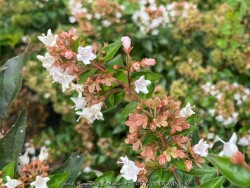

Raspberry Profusion Abelia (Abelia chinensis 'Raspberry Profusion') is a compact rounded, spreading, multi-stemmed shrub in the honeysuckle family. Typically grows on gracefully arching branches to 2-4' tall. 'Raspberry Profusion', a seedling selection of 'Edward Goucher' x chinensis, blooms heavily from May to September. The entire plant is covered with big clusters of strongly-scented, pink flowers with flamboyant raspberry sepals. The sepals remain after the flowers drop, extending the color until the end of autumn. New growth emerges glossy red and ages to a handsome dark green. The shrub is robust and compact, growing to 3-4' tall and wide. It is mostly deciduous in the winter. Semi-evergreen dark green leaves turn purplish-bronze in autumn persisting until 10 degrees F or so. Wood is hardy to 0 degrees F. In years where the stems die to the ground in winter but the plant survives, flowering will still occur on new growth. 'Raspberry Profusion' Abelia (Abelia chinensis 'Raspberry Profusion') is an unusually hardy abelia, thriving even in zone 5b. Abelia is also known for it's fragrant flowers that attract butterflies and hummingbirds, plus it's shade-tolerant and resistant to both deer and rabbits. Graceful, arching habit makes it a perfect choice for late season fragrance in your landscape.
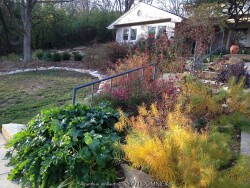

Bear's Breeches / Acanthus is a clump-forming perennial that is grown as much for its attractive dark green foliage as for its architecturally bold flower spikes. It is native to the Mediterranean region. Flowers are creamy white (sometimes pinkish) and snapdragon-like. Foliage is mostly evergreen in warm winter climates, but plants lose their leaves when winter temperatures dip below 20°F. Foliage is usually persisting until mid-early December in Kansas. If low temperatures hit -10 degrees F, it may kill an un-mulched plant; protect any zone 6 perennial with thick layer of mulch. Established plants survived -16 degrees F and a week of single digit highs in February, 2021. Acanthus may be grown a potted patio plant for full to part shade. Grown in a raised pot, they are hardy to about 15-20° so you may be able to miss the first few frosts when moving them in for the winter. Before extreme cold, overwinter in a dark garage or basement with monthly watering to encourage dormancy. Alternatively, it can maintain growing in a bright window as a houseplant. Either way, they will hold up very well in the winter and maintain their attractive foliage. In spring, just cut off dead foliage and place back out in April or May with a time-release fertilizer.
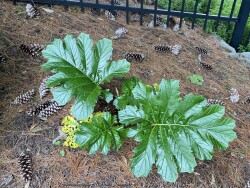

Bear's Breeches / Acanthus is a clump-forming perennial that is grown as much for its attractive dark green foliage as for its architecturally bold flower spikes. It is native to the Mediterranean region. Flowers are creamy white (sometimes pinkish) and snapdragon-like. Foliage is mostly evergreen in warm winter climates, but plants lose their leaves when winter temperatures dip below 20°F. Foliage is usually persisting until mid-early December in Kansas. If low temperatures hit -10 degrees F, it may kill an un-mulched plant; protect any zone 6 perennial with thick layer of mulch. Established plants survived -16 degrees F and a week of single digit highs in February, 2021. Acanthus may be grown a potted patio plant for full to part shade. Grown in a raised pot, they are hardy to about 15-20° so you may be able to miss the first few frosts when moving them in for the winter. Before extreme cold, overwinter in a dark garage or basement with monthly watering to encourage dormancy. Alternatively, it can maintain growing in a bright window as a houseplant. Either way, they will hold up very well in the winter and maintain their attractive foliage. In spring, just cut off dead foliage and place back out in April or May with a time-release fertilizer. Acanthus mollis 'Wofford Rhubarb' features beautiful red leaf stalks.
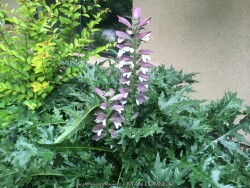

Spiny Bear's Breeches (Acanthus spinosus) is a clump-forming perennial that is grown as much for its attractive dark green foliage as for its architecturally bold flower spikes. The foliage of this species deeply cut and rather spiny looking dark-green leaves without actual spines. Flowers are creamy white (sometimes pinkish) and snapdragon-like and DO have sharp spines! It is the most thistly-looking of any of the various forms available. Foliage is mostly evergreen in warm winter climates, but plants lose their leaves when winter temperatures dip below 20°F. Foliage is usually persisting until mid-early December in Kansas. If low temperatures hit -10 degrees F, it may kill an un-mulched plant; protect any zone 6 perennial with thick layer of mulch. Established plants survived -16 degrees F and a week of single digit highs in February, 2021.


Five leaf Akebia (Akebia quinata) is a twining vine with green leaves arranged in a palmate shape. Maroon to purple flowers have the slight aroma of chocolate and bloom early in the spring. As with most vines, they are not low maintenance due to their nature and purpose in life. Vines by nature are kind of like freeloaders that want to use other things (and other plants) for free support. This does not directly parasitize the tree but can add a lot of weight (storm damage) and shade out it's foliage. It requires training to grow on some structures but will generally twine and try to grow to the highest point possible. When properly trained on a trellis or pergola, akebia can be amazing. It will grow in just about any soil and tolerate full shade to full sun. It may be used as a groundcover if nothing to climb on or an edible plant if you pollinate the flowers by hand. There are varieties available that when crossed, produce edible fruit. Akebia is invasive in some parts of the country but this is not the case in Kansas. Blooms occur in march or april very early when frosts are still occurring but with little damage to the plant. Foliage is persistent and semi evergreen until 10-15 degrees F.
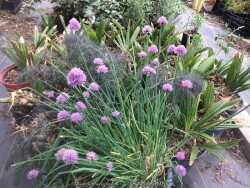

Chives (Allium schoenoprasum) are an easy to grow edible and ornamental perennial. Attractive, globular, clover-like clusters of pale purple flowers appear in spring and early summer. Grow in just about any soil including heavy clay in full to part sun. In Eastern Kansas, typically our 40 inches of rainfall is sufficient without extra water. And as with all alliums, these are completely rabbit proof. Considered a "Once it's there, it's there forever" plant!
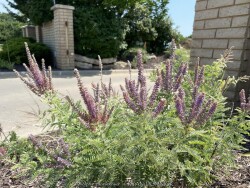

Leadplant (Amorpha canescens) is a small, deciduous perennial semi-shrub, 1-3 ft. tall, with tiny, purple flowers grouped together in colorful, terminal spikes with orange pollen. The blooming season is relatively short but the pinnately compound leaves offers lasting interest and a "Wow" factor. Leadplant can be found in many locations throughout North America but mostly in the midwest USA. Disjunct populations also exist in Texas, New Mexico and Colorado but skipping the fire-prone areas of the Great Plains. Leadplant is typically found in dry prairie pockets of land that are not overgrown, do not burn frequently, and experience minimal live-stock grazing. Leadplant grows best in drier, well-drained soil of many different textures including sandy, gravely, and rocky soils. Leadplant needs full sun for flowering and to avoid floppiness. Mainly used in Kansas landscapes in native prairie gardens, it tolerates considerable drought and alkaline limestone clay soils. It does best on a berm with great drainage or un-irrigated parking lot islands and "hell-strips". Leadplant has only one pest problem and that is rabbits! If rabbits are an issue, just put a bowl-shaped chicken wire cage around the plants for the first year. By year #2, the rapidly growing foliage will outgrow any detrimental rabbit browsing. This is definitely one of the most adapted native landscape shrubs in Kansas zone 6a with no problems with heat, cold, or drought! It's hard to imagine a native perennial garden without this plant! Butterflies will thank you!
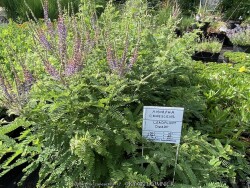

Leadplant (Amorpha canescens) is a small, deciduous perennial semi-shrub, 1-3 ft. tall, with tiny, purple flowers grouped together in colorful, terminal spikes with orange pollen. The blooming season is relatively short but the pinnately compound leaves offers lasting interest and a "Wow" factor. Leadplant can be found in many locations throughout North America but mostly in the midwest USA. Disjunct populations also exist in Texas, New Mexico and Colorado but skipping the fire-prone areas of the Great Plains. Leadplant is typically found in dry prairie pockets of land that are not overgrown, do not burn frequently, and experience minimal live-stock grazing. Leadplant grows best in drier, well-drained soil of many different textures including sandy, gravely, and rocky soils. Leadplant needs full sun for flowering and to avoid floppiness. Mainly used in Kansas landscapes in native prairie gardens, it tolerates considerable drought and alkaline limestone clay soils. It does best on a berm with great drainage or un-irrigated parking lot islands and "hell-strips". Leadplant has only one pest problem and that is rabbits! If rabbits are an issue, just put a bowl-shaped chicken wire cage around the plants for the first year. By year #2, the rapidly growing foliage will outgrow any detrimental rabbit browsing. This is definitely one of the most adapted native landscape shrubs in Kansas zone 6a with no problems with heat, cold, or drought! It's hard to imagine a native perennial garden without this plant! Butterflies will thank you!
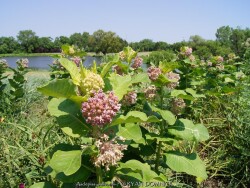

***Description for this perennial available with future update!***


***Description for this perennial available with future update!***
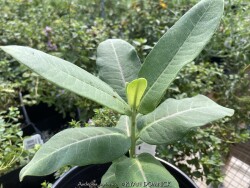

***Description for this perennial available with future update!***
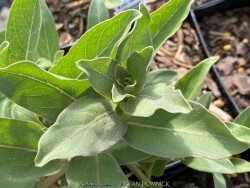

***Description for this perennial available with future update!***


The False Indigo species (Baptisia) features beautiful compact bluish green leaves arranged in groups of three. Like many members in the legume family, they are nitrogen fixing plants which means they produce their own nitrogen in the soil through a symbiotic relationship with bacteria. The flowers bloom above the foliage normally in April and May. Common baptisia flower colors include white, purple, lavender, yellow, and pink as well as uncommon colors ranging from deep purple to maroon and even coppery orange. Considered a great North American native three season plant, the foliage always emerges very attractive followed by flowers that do not need deadheading. Foliage generally lasts pretty nice through hot summers and into fall turning black with first freeze. Seed pods also turn charcoal black when ripe and have considerable ornamental interest and useful in dried flower arrangements. At some point in the fall, it can be cut down early for a clean look or left for winter interest. Baptisia generally do well in droughty clay soils in full to part sun. There is only one pest that may create problems called the Genista Broom Moth. It may occur in Kansas when weather conditions are consistently dry and over 95 degrees F. It is treatable if you act fast but if not, it only destroys the foliage late in the season and does not kill the plant. Baptisia has several enormous spreading taproots which store water and energy and can make transplanting difficult. Plantings look good as specimen or in small groups; and it's ok even preferable if they grow together and touch other plants. That helps eliminate available sunlight and discourages weeds. It is hard to picture a native plant garden or any perennial garden without Baptisia. Considered a once "it's there, it's always there" plant. According to Walters Gardens, Baptisia 'Violet Dusk' features "lavender violet flowers with cream keels makes this a stunning display for the early season garden. Its claim to fame is its unique vase-like habit. Although this plant is 3' wide, the base of the plant takes up a relatively small footprint, leaving space to under plant with other perennials. In comparison to other Baptisia in our trials, 'Violet Dusk' is relatively late to bloom." This extremely long-lived perennial could be used instead of a shrub in landscape settings, with minimal care required to thrive year after year.
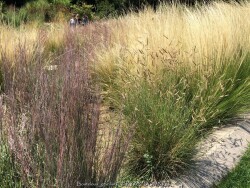

Blue Grama Grass (Bouteloua gracilis) is a long-lived, clump-forming, warm-season, perennial grass native to North America. It is one of the dominant grasses of the dry shortgrass prairies. Blue grama has very thin green to greyish leaves that turn golden brown in autumn, sometimes also developing interesting shades of orange. Purplish-tinged eyebrow-shaped flowers appear on arching stems above the foliage in early to mid-summer. Height before flowering is 12-15" increasing to 24" after flowering. As a native to the Great Plains, blue grama displays excellent drought tolerance but tolerates a wide range of soils. Avoid poorly-drained soils. In Eastern Kansas, typically our 40 inches of rainfall is sufficient without extra water. Occasionally suffering from excessive rainy spells and high humidity, foliage rust diseases can be a problem in shade or poor air circulation areas. To counteract that in Kansas, plant in full sun on berm with poor sandy, rocky, or clay soil with no irrigation. Blue grama grass works very well in an ornamental grass garden adding contrast, texture, and short stature. Use as mass plantings to create a drift that can be enjoyed from far away. For mass plantings, plant individual plants close together as they don't spread much. Dried foliage holds up very well in the winter offering a one-of-a-kind look. The only maintenance is to cut down or burn before new growth emerges. Combine with other flowering prairie native perennials for a long season of interest. Also useful as a full-sun turf grass for extremely dry or sandy soils or where buffalo grass doesn't work. It can be regularly mowed to 3-4" high.
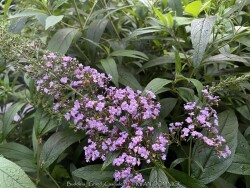

Butterfly Bush (Buddleia) are workhorses in the pollinator garden. Flower panicles come in a variety of colors mostly including shades of lavender, magenta, violet, pink, and white. Most Butterfly Bushes bloom on new wood so trimming off winter kill or complete rejuvenation will not affect flowering. In fact, flowering is often bigger and bolder from new water sprout growth when trimmed to the ground each year. Most Butterfly Bushes in zone 6 are maintained this way. Foliage is typically an attractive greenish-gray to mint green and persists into the fall until hard freezes occur. Use in the landscape in small or large groupings for its amazing flower power! Plants grow best in full sun with medium to dry soils. Drought tolerance is high with established plants so extra watering is rarely needed in our East Kansas climate with 40 inches of rain per year. Obviously, Butterfly Bush attracts lots of butterflies. There has been some debate in recent years on whether to plant Butterfly Bush because it's a non-native plant. Being a native of China, it has no pest or disease problems here. It is invasive in some parts of the country but cold Kansas winters keep it and check and without any self-seeding problems here. If you are still worried about it, there are several sterile varieties to choose from. There have been many drastically improved cultivars in the last 10 years aiming to improve cold hardiness, bloom size, eliminate seeding, and improve growth habits. Buddleia 'Grand Cascade' is an introduction by Walters Gardens, Inc. Unlike the typical Butterfly Bush, the panicles on this flowering shrub cascade downward, similar to the look of weeping willow or a bridalwreath spirea. Light lavender purple flower panicles are enormous at 12-14" long and 4" thick. They're nearly the size of your head! In Eastern Kansas, 'Grand Cascade' has performs WELL for over 3 years with just about everything nature has to challenge it! This is a larger Butterfly Bush growing to 5-6' but still dense and compact in appearance. Combine with caryopteris and crapemyrtle to create a late season "all you can eat" buffet for pollinators!


Butterfly Bush (Buddleia) are workhorses in the pollinator garden. Flower panicles come in a variety of colors mostly including shades of lavender, magenta, violet, pink, and white. Most Butterfly Bushes bloom on new wood so trimming off winter kill or complete rejuvenation will not affect flowering. In fact, flowering is often bigger and bolder from new water sprout growth when trimmed to the ground each year. Most Butterfly Bushes in zone 6 are maintained this way. Foliage is typically an attractive greenish-gray to mint green and persists into the fall until hard freezes occur. Use in the landscape in small or large groupings for its amazing flower power! Plants grow best in full sun with medium to dry soils. Drought tolerance is high with established plants so extra watering is rarely needed in our East Kansas climate with 40 inches of rain per year. Obviously, Butterfly Bush attracts lots of butterflies. There has been some debate in recent years on whether to plant Butterfly Bush because it's a non-native plant. Being a native of China, it has no pest or disease problems here. It is invasive in some parts of the country but cold Kansas winters keep it and check and without any self-seeding problems here. If you are still worried about it, there are several sterile varieties to choose from. There have been many drastically improved cultivars in the last 10 years aiming to improve cold hardiness, bloom size, eliminate seeding, and improve growth habits. Buddleia x 'Pugster Amethyst' is a compact Butterfly Bush reaches just 2-3' tall and wide but has the large, full flowers normally seen on a much larger plant. It blooms non-stop from early summer through frost with amethyst-toned flowers, each with a tiny yellow-orange eye in the center. Thanks to thick, sturdy stems, the Pugster® series offers vastly improved hardiness and winter survival over other types of dwarf Butterfly Bush. Thanks to its long-blooming habit, Pugster Butterfly Bushes add low-maintenance color to any sunny spot in your yard. The name "Pugster" comes from these plants' resemblance to a pug - short, stocky, and cute! In Eastern Kansas, this cultivar performs WELL with just about everything nature has to challenge it! Heat and drought are tolerated. Cold tolerance is no problem in our zone 6. If winter die-back occurs, cut back in March/April and flowers will occur on new growth this year. No disease or pest problems. Combine with caryopteris and crapemyrtle to create a late season "all you can eat" buffet for pollinators! All Proven Winners® plants are legally propagated, healthy and vigorous, true to name, and tagged with color pictures and growing information.
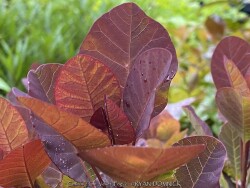

>>>>>In the words of breeder Tim Wood - "It's got more smoke than a KISS concert!" (Cotinus 'The Velvet Fog') Very large pink plumes develop in mid-summer, covering the waxy blue-green foliage. It's a stunning color combination. The Velvet Fog smokebush (Cotinus 'The Velvet Fog') was selected for its outstanding flower production as well as its dense growth, providing a lusher look than conventional cotinus. Pruning will rarely be required but may be done in spring. It isn't technically the flowers that create the hazy, smoke-like effect this plant is so loved for - it's the seed pods that form after the flowers have faded. In Eastern Kansas, this cultivar performs WELL with just about everything nature has to challenge it! Heat and drought are preferred and need hot microclimate. Cold tolerance is no problem. Some leaf disease appears by late season from excessive rains and high humidity sometimes causing early defoliation. An important note about pruning: Do not attempt to rejuvinate an older tree/shrub in early fall. This will trick it into growing back rapidly to recover and them WHAM!.Arctic cold blast arrives killing any new growth not hardened off. This double sapps the tree for nutrients usually resulting in death by spring. All Proven Winners® plants are legally propagated, healthy and vigorous, true to name, and tagged with color pictures and growing information.
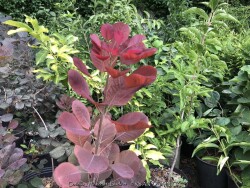

>>>>>A feast for the eyes from spring through autumn! Winecraft Black® Smoketrtee (Cotinus 'Winecraft Black') is the first Proven Winners smokebush, so you know it must be special. In spring, round leaves emerge rich purple but as summer's heat comes on, they turn a deep near-black tone and finally light up in an array of reds and oranges in fall. In early summer, large, soft panicles of bloom appear that become the misty "smoke" that makes this such a popular landscape plant. Unlike other smokebush, it naturally has a rounded, dwarf habit which means that finally, every landscape has room for this unique plant. Top three reasons to grow Winecraft Black smokebush: 1.Color and interest from spring through frost. 2.No pruning or special maintenance required. 3.Dwarf habit makes it easy to use with any sized home or yard. Uses Notes: Smokebush makes a striking specimen, but is also effective as a low hedge or mass planting. Maintenance Notes: Winecraft Black smokebush is very easy to care for and requires little to nothing in the way of regular maintenance. Plant in full sun for best color and flowering. Pruning will rarely be required but may be done in spring. It isn't technically the flowers that create the hazy, smoke-like effect this plant is so loved for - it's the seed pods that form after the flowers have faded. In Eastern Kansas, this cultivar performs WELL with just about everything nature has to challenge it! Heat and drought are preferred and need hot microclimate. Cold tolerance is no problem. Some leaf disease appears by late season from excessive rains and high humidity sometimes causing early defoliation. An important note about pruning: Do not attempt to rejuvinate an older tree/shrub in early fall. This will trick it into growing back rapidly to recover and them WHAM!.Arctic cold blast arrives killing any new growth not hardened off. This double sapps the tree for nutrients usually resulting in death by spring. All Proven Winners® plants are legally propagated, healthy and vigorous, true to name, and tagged with color pictures and growing information.


>>>>>A beaming beacon for the landscape. Bold, bright, and beautiful: that's Winecraft Goldtm Smokebush (). Round, waxy leaves emerge a sunny orange, soon take on a golden hue, then mature to a cheerful chartreuse for the season. In early summer, cloud-like green flower clusters cover the plant, and these turn into the pink "smoke" plumes that earn the plant its name. Naturally grows with a dense, oval shape that's ideal for adding a spot of bright color to partially shaded or sunny areas. Top reasons to grow Winecraft Gold smokebush: 1. bright golden foliage, 2. memorable smoke-like seedheads in summer, 3. smaller and more dense than conventional smokebush. Uses Notes: Makes a lovely specimen or addition to perennial gardens and flower borders. Maintenance Notes: It's best to avoid pruning smokebush regularly, though you may selectively remove branches to attain the shape you desire. It's quite versatile and easy to grow, but do note that this golden selection is a bit less cold tolerant than other smokebush. In Eastern Kansas, this cultivar performs WELL with just about everything nature has to challenge it! Heat and drought are preferred and need hot microclimate. Cold tolerance is no problem. Some leaf disease appears by late season from excessive rains and high humidity sometimes causing early defoliation. An important note about pruning: Do not attempt to rejuvinate an older tree/shrub in early fall. This will trick it into growing back rapidly to recover and them WHAM!.Arctic cold blast arrives killing any new growth not hardened off. This double sapps the tree for nutrients usually resulting in death by spring. All Proven Winners® plants are legally propagated, healthy and vigorous, true to name, and tagged with color pictures and growing information.
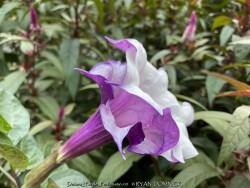

***Description for this plant available with future update!***
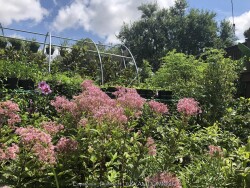

Phantom Dwarf Purple Eupatorium, is also known as Eupatorium 'Phantom'
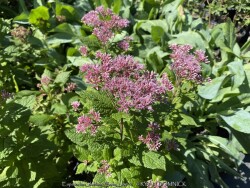

Little Joe Purple Eupatorium / Joe Pye, is also known as Eupatorium dubium 'Little Joe'
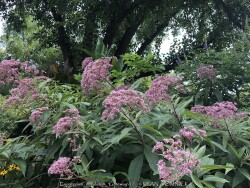

Gateway Purple Eupatorium / Joe Pye, is also known as Eupatorium maculatum 'Gateway'
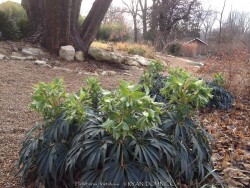

Bear Claw / Stinking Hellebore (Helleborus foetidus) is the ultimate dry-shade plant for eastern Kansas landscapes. Most hellebores are native to mountainous wooded regions of Europe and Asia with limestone bedrock and calcareous, humus-rich soils. They have everything a gardener might ask for; beautiful spring flowers, dependable dark green foliage, evergreen during winter, appreciation for alkaline soils, and ease of care with very low maintenance. Hellebores are one of the first perennials to start growing in the spring with flowering occurring even with hard freezes. Bear Claw Hellebore literally starts blooming in January and February in zone 6a. The drooping cup-shaped flowers appear in spring, and are yellowish-green, often with a purple edge to the five petal-like sepals on strongly upright stems. The flowers are very attractive to bees and other insects at a time of year when hardly any other plant (except Witchhazel / Hamamelis) is blooming. Despite its common name, it is not noticeably malodorous, although the foliage is pungent when crushed. Greenish flowers last incredibly long 2 to 3 months and finally turn brown in May and should be dead-headed. Summer and fall foliage is bear claw-like, dark green, dependable, and pest-free. Evergreen foliage is hardy to about -10°F with complete death occurring at about -15°F for unmulched plants. Desirable self-seeding will occur around mother plants. Individual plants of this species usually live for 3-4 years so it is advisable to allow a patch of different aged plants. Flowering usually occurs at 2-3 years. Hellebores do have an Achilles heel however; they cannot tolerate wet or poorly drained soils, not even slightly. In areas with too much rainfall or poorly drained soils, foliage diseases and root rot are likely to occur. Hellebores are also not the best choice for full sun, while they will survive, they will get foliage burn in the summer when over 100°F in afternoon sun. This hellebore is less adapted to consistent summer heat and humidity of zone 7b areas or South. With poisonous foliage, these plants resist deer and rabbit browsing. What a great plant for the dry shade garden! There are a few interesting and improved cultivars but are rarely available.
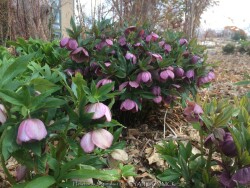

Lenten Rose (Helleborus) is the ultimate dry-shade plant for eastern Kansas landscapes. Most hellebores are native to mountainous wooded regions of Europe with limestone bedrock and calcareous, humus-rich soils. They have everything a gardener might ask for; beautiful spring flowers, dependable dark green foliage, evergreen during winter, appreciation for alkaline soils, and ease of care with very low maintenance. Hellebores are one of the first perennials to start growing in the spring with flowering occurring even with hard freezes. Flowers last incredibly long 2 to 3 months and finally turn greenish in June. No deadheading is needed because the foliage just absorbs the flower stalks as they fade. Summer and fall foliage is dark green, dependable, and pest-free. Evergreen foliage is hardy to about 0°F. If it gets colder than that, hellebores will be deciduous with no detrimental effects. Desirable self-seeding may gently occur around mother plants. Hellebores do have an Achilles heel however; they cannot tolerate wet or poorly drained soils, not even slightly. In areas with too much rainfall or poorly drained soils, foliage diseases and root rot are likely to occur. Hellebores are also not the best choice for full sun, while they will survive, they will get foliage burn in the summer when over 100°F in afternoon sun. With poisonous foliage, these plants resist deer and rabbit browsing. What a great plant for the dry shade garden! There are many improved flowering cultivars to choose from now.


Lenten Rose (Helleborus) is the ultimate dry-shade plant for eastern Kansas landscapes. Most hellebores are native to mountainous wooded regions of Europe with limestone bedrock and calcareous, humus-rich soils. They have everything a gardener might ask for; beautiful spring flowers, dependable dark green foliage, evergreen during winter, appreciation for alkaline soils, and ease of care with very low maintenance. Hellebores are one of the first perennials to start growing in the spring with flowering occurring even with hard freezes. Flowers last incredibly long 2 to 3 months and finally turn greenish in June. No deadheading is needed because the foliage just absorbs the flower stalks as they fade. Summer and fall foliage is dark green, dependable, and pest-free. Evergreen foliage is hardy to about 0°F. If it gets colder than that, hellebores will be deciduous with no detrimental effects. Desirable self-seeding may gently occur around mother plants. Hellebores do have an Achilles heel however; they cannot tolerate wet or poorly drained soils, not even slightly. In areas with too much rainfall or poorly drained soils, foliage diseases and root rot are likely to occur. Hellebores are also not the best choice for full sun, while they will survive, they will get foliage burn in the summer when over 100°F in afternoon sun. With poisonous foliage, these plants resist deer and rabbit browsing. What a great plant for the dry shade garden! There are many improved flowering cultivars to choose from now.
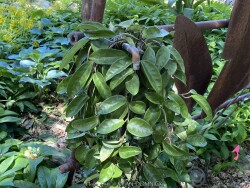

Wax Plants (Hoya sp.) have been popular house plants for decades because they are extremely long-lived, have a classic, deep green, vining foliage and produce fragrant, light pink and red star-shaped flowers. Because of their thick waxy foliage, they are often called wax plants. These tropical vines have a few requirements in order to thrive but nothing too hard. Give them bright indirect light and water only when dry. If light, temperature, and humidity are sufficient, flowers may occur. If not, then just enjoy the beautiful foliage. They are usually grown as a house plant in Kansas but can be moved outside in the summer if kept in full shade. Leaves will sunburn easily! In the wild, most species grow in dry-deciduous jungles that never get below 60 degrees F. Repotting may or may not be needed depending on how large you want the plant to grow; plants can continue to grow in the same pot for decades. If repotting, make sure to use a sharp draining but high organic cactus mix with plenty of sand and perlite. To play is safe, outside potted plants are best moved in before night temperatures get below 50 degrees F. It is important to avoid the combination of wet and cold. Potted plants are very low maintenance but watch for scale and mealybugs that may hide beneath the foliage.
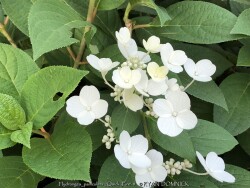

Quick Fire Fab® Panicle Hydrangea (Hydrangea paniculata 'Quick Fire Fab') is the first to bloom! Quick Fire blooms about a month before any other panicle hydrangea. Flowers open pure white then turn pink, and will be an extremely dark rosy-pink in the fall. The flower color on Quick Fire hydrangea is not affected by soil pH. Blooms on this super-hardy and easy to grow hydrangea are produced on new wood, which means that you will see flowers even after even the harshest winters. Beautiful for use as a cut (fresh or dried) flower. Unlike other panicle hydrangeas, Quick Fire Fab also has excellent fall foliage color for a final hurrah before winter. This is a very hardy flowering shrub good for full sun locations - the hotter your climate, however, the more shade the plant will require. Good for groupings and in mass plantings, shrub and perennial borders, as a specimen, a screen or a hedge. Panicle hydrangeas like Quick Fire Fab are very easy to care for. They can grow in most soils, provided they are well-drained. Panicle hydrangeas bloom on new wood, which means they can be pruned in spring and will still bloom that season. We recommend cutting them back by about one-third their total height in early spring, just as the new growth is beginning to emerge on the stems. This will serve to remove the spent blooms and ensure that the season's growth comes from the heavier, thicker buds further down the plant. If blooms do not age to pink and red, this indicates that the plant is either in too much shade, that it experienced drought stress, or that night time temperatures were unusually high. In Eastern Kansas, this cultivar performs reasonably well. Heat and drought are tolerated if in morning sun. In full sun provide ample water and expect some leaf burn if summer temperatures exceed 100 degrees F. Cold tolerance is no problem. No disease or pest problems. All Proven Winners® plants are legally propagated, healthy and vigorous, true to name, and tagged with color pictures and growing information.
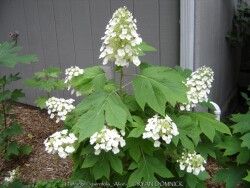

>>>>>Oakleaf hydrangea (Hydrangea quercifolia) is a large coarse-textured deciduous shrub growing to 3-10 feet tall with an open crown native to the southeastern United States. Cone-shaped flower clusters emerge bright white in mid-summer. Flowers age to progressively darker shades of pink and by autumn and become persistent dried flower-heads in winter. The leaves are dark green on top and silvery-white underneath. Plants in shade have larger leaves than those grown in sun. In sun, if drought stress occurs, foliage becomes tattered, burnt, and yellowish; ruining potential fall color. The leaves of healthy plants turn rich shades of red, bronze and purple in autumn that persist until about 25 degrees F usually into late November in Kansas. The plant slowly sprouts shoots from underground stolons and often grows in colonies in ideal conditions but this is rare in Kansas. Young stems are covered in a felt-like light brown bark while the larger stems develop an attractive cinnamon-tan-orange bark that shreds and peels in thin flakes. Hydrangea quercifolia is best grown in rich, medium moisture, well-drained soils in part shade. Drought and full sun tolerance are average but greatly improved with rich, moisture-retentive foresty soils. Plant near gutter downspouts for an extra boost of water. It will tolerate drought, but may not flower. In Eastern Kansas, Cold tolerance is no problem. No significant disease or pest problems. Of all the hydrangeas, this is probably the toughest! Several improved cultivars have been developed.
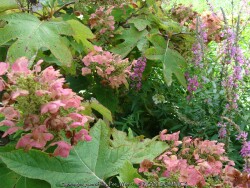

>>>>>Oakleaf hydrangea (Hydrangea quercifolia) is a large coarse-textured deciduous shrub growing to 3-10 feet tall with an open crown native to the southeastern United States. Cone-shaped flower clusters emerge bright white in mid-summer. Flowers age to progressively darker shades of pink and by autumn and become persistent dried flower-heads in winter. The leaves are dark green on top and silvery-white underneath. Plants in shade have larger leaves than those grown in sun. In sun, if drought stress occurs, foliage becomes tattered, burnt, and yellowish; ruining potential fall color. The leaves of healthy plants turn rich shades of red, bronze and purple in autumn that persist until about 25 degrees F usually into late November in Kansas. The plant slowly sprouts shoots from underground stolons and often grows in colonies in ideal conditions but this is rare in Kansas. Young stems are covered in a felt-like light brown bark while the larger stems develop an attractive cinnamon-tan-orange bark that shreds and peels in thin flakes. Hydrangea quercifolia is best grown in rich, medium moisture, well-drained soils in part shade. Drought and full sun tolerance are average but greatly improved with rich, moisture-retentive foresty soils. Plant near gutter downspouts for an extra boost of water. It will tolerate drought, but may not flower. In Eastern Kansas, Cold tolerance is no problem. No significant disease or pest problems. Of all the hydrangeas, this is probably the toughest! Several improved cultivars have been developed.
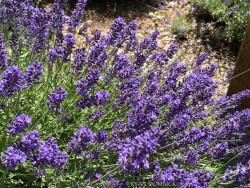

Lavender (Lavandula angustifolia 'Munstead') is one of the most well-known flowers and herbal qualities. It features grayish green aromatic and evergreen foliage with lavender flowers. Blooming usually starts during the heat of summer and continues until frost. Lavender is native to Mediterranean climates with average moisture in the summer and dry, mild winters. Because of its heritage, it resents cold wet winters and needs well drained sandy, silty, or rocky soil. In the short term, it will typically grow in any soil during the summer making it very useful even as an annual. In Kansas landscapes, it is commonly used as an annual or short-lived perennial where lots of color is needed in full sun. Root rot is likely when placed in poor draining soil or even in rich garden soil. Summer heat is usually not a problem but not extreme heat of a south or west wall. Lavender does reasonably well growing out of retaining walls or on top of retaining walls with perfect drainage. Lavender is actually a woody shrub but grown like a in perennial because every so often do you need to trim it back to a few inches off the ground. Lavender combines nicely with any red, orange, or yellow flower or where needing a perennial with evergreen winter color. Lavandula angustifolia 'Munstead' is a commonly sold cultivar.


Lavender is one of the most well-known flowers and herbal qualities. It features grayish green aromatic and evergreen foliage with lavender flowers. Blooming usually starts during the heat of summer and continues until frost. Lavender is native to Mediterranean climates with average moisture in the summer and dry, mild winters. Because of its heritage, it resents cold wet winters and needs well drained sandy, silty, or rocky soil. In the short term, it will typically grow in any soil during the summer making it very useful even as an annual. In Kansas landscapes, it is commonly used as an annual or short-lived perennial where lots of color is needed in full sun. Root rot is likely when placed in poor draining soil or even in rich garden soil. Summer heat is usually not a problem but not extreme heat of a south or west wall. Lavender does reasonably well growing out of retaining walls or on top of retaining walls with perfect drainage. Lavender is actually a woody shrub but grown like a in perennial because every so often do you need to trim it back to a few inches off the ground. Lavender combines nicely with any red, orange, or yellow flower or where needing a perennial with evergreen winter color. Lavandula angustifolia 'Munstead' is a commonly sold cultivar.
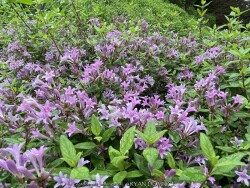

Purple Flowering Leptodermis, is also known as Leptodermis oblonga


Big Blue Liriope (Liriope muscari 'Big Blue') grows to form a dense, dark green, grass-like groundcover in medium to full shade. As one of the very best "dry-shade" plants, it has environmental and economic traits that can help conserve water and lower your water bill! Plantings can thrive for decades if in the right spot; there is no such thing as overcrowding for Liriope. When planted in mass, growth is slow at first but eventually a cake-like rhizome system will form and completely smother out any weeds and compete well with trees for water and nutrients. Even under the most hostile conditions such as huge silver maple and pin oak trees, liriope not only survives but thrives. While Big Blue Liriope can tolerate full sun, they prefer part to full shade. Sun burning is possible with temperatures over 100° and there are better plants to use in hot areas. Liriope has no insect or disease problems, will survive droughts, short-term floods and cold winters. In the winter, it will stay green until 0 degrees F and be completely evergreen some winters. Liriope also thrives in summer with the worst heat and humidity even in the Southeast and Southwest! Liriope is tolerant of a wide range of soil types but prefers clay/loam and will display best growth in fertile soils with average water but extremely drought tolerant in shaded areas! For the home garden, the species spreads slowly so you shouldn't leave very much room in-between Liriope plants or you will be waiting many years for the patch to fill in. Weeds can be a problem in that open area between plants if spacing is too wide. We recommend 12-18" spacing for a larger area. The only problem we have seen is a mysterious crown-rot disease in well-irrigated gardens. This liriope (Liriope muscari 'Big Blue') does not spread very quickly or much at all compared to Spreading Liriope / Monkey Grass (Liriope spicata) This is a real trooper for the dry shade garden!
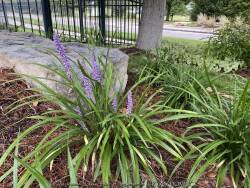

Classic Blue Clump-forming Liriope (Liriope muscari 'Classic Blue' / 'Ingwersen') grows to form a dense, dark green, grass-like groundcover in medium to full shade. As one of the very best "dry-shade" plants, it has environmental and economic traits that can help conserve water and lower your water bill! Plantings can thrive for decades if in the right spot; there is no such thing as overcrowding for Liriope. When planted in mass, growth is slow at first but eventually a cake-like rhizome system will form and completely smother out any weeds and compete well with trees for water and nutrients. Even under the most hostile conditions such as huge silver maple and pin oak trees, liriope not only survives but thrives. While Big Blue Liriope can tolerate full sun, they prefer part to full shade. Sun burning is possible with temperatures over 100° and there are better plants to use in hot areas. Liriope has no insect or disease problems, will survive droughts, short-term floods and cold winters. In the winter, it will stay green until 0 degrees F and be completely evergreen some winters. Liriope also thrives in summer with the worst heat and humidity even in the Southeast and Southwest! Liriope is tolerant of a wide range of soil types but prefers clay/loam and will display best growth in fertile soils with average water but extremely drought tolerant in shaded areas! For the home garden, the species spreads slowly so you shouldn't leave very much room in-between Liriope plants or you will be waiting many years for the patch to fill in. Weeds can be a problem in that open area between plants if spacing is too wide. We recommend 12-18" spacing for a larger area. The only problem we have seen is a mysterious crown-rot disease in well-irrigated gardens. This liriope (Liriope muscari 'Classic Blue' / 'Ingwersen') does not spread very quickly or much at all compared to Spreading Liriope / Monkey Grass (Liriope spicata) This is a real trooper for the dry shade garden!
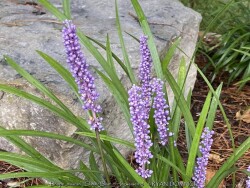

Classic Blue Clump-forming Liriope (Liriope muscari 'Classic Blue' / 'Ingwersen') grows to form a dense, dark green, grass-like groundcover in medium to full shade. As one of the very best "dry-shade" plants, it has environmental and economic traits that can help conserve water and lower your water bill! Plantings can thrive for decades if in the right spot; there is no such thing as overcrowding for Liriope. When planted in mass, growth is slow at first but eventually a cake-like rhizome system will form and completely smother out any weeds and compete well with trees for water and nutrients. Even under the most hostile conditions such as huge silver maple and pin oak trees, liriope not only survives but thrives. While Big Blue Liriope can tolerate full sun, they prefer part to full shade. Sun burning is possible with temperatures over 100° and there are better plants to use in hot areas. Liriope has no insect or disease problems, will survive droughts, short-term floods and cold winters. In the winter, it will stay green until 0 degrees F and be completely evergreen some winters. Liriope also thrives in summer with the worst heat and humidity even in the Southeast and Southwest! Liriope is tolerant of a wide range of soil types but prefers clay/loam and will display best growth in fertile soils with average water but extremely drought tolerant in shaded areas! For the home garden, the species spreads slowly so you shouldn't leave very much room in-between Liriope plants or you will be waiting many years for the patch to fill in. Weeds can be a problem in that open area between plants if spacing is too wide. We recommend 12-18" spacing for a larger area. The only problem we have seen is a mysterious crown-rot disease in well-irrigated gardens. This liriope (Liriope muscari 'Classic Blue' / 'Ingwersen') does not spread very quickly or much at all compared to Spreading Liriope / Monkey Grass (Liriope spicata) This is a real trooper for the dry shade garden!
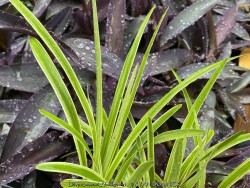

Variegated Liriope (Liriope muscari 'Variegata') grows to form a dense, dark green, grass-like groundcover in medium to full shade. As one of the very best "dry-shade" plants, it has environmental and economic traits that can help conserve water and lower your water bill! Plantings can thrive for decades if in the right spot; there is no such thing as overcrowding for Liriope. When planted in mass, growth is slow at first but eventually a cake-like rhizome system will form and completely smother out any weeds and compete well with trees for water and nutrients. Even under the most hostile conditions such as huge silver maple and pin oak trees, liriope not only survives but thrives. While Big Blue Liriope can tolerate full sun, they prefer part to full shade. Sun burning is possible with temperatures over 100° and there are better plants to use in hot areas. Liriope has no insect or disease problems, will survive droughts, short-term floods and cold winters. In the winter, it will stay green until 0 degrees F and be completely evergreen some winters. Liriope also thrives in summer with the worst heat and humidity even in the Southeast and Southwest! Liriope is tolerant of a wide range of soil types but prefers clay/loam and will display best growth in fertile soils with average water but extremely drought tolerant in shaded areas! For the home garden, the species spreads slowly so you shouldn't leave very much room in-between Liriope plants or you will be waiting many years for the patch to fill in. Weeds can be a problem in that open area between plants if spacing is too wide. We recommend 12-18" spacing for a larger area. The only problem we have seen is a mysterious crown-rot disease in well-irrigated gardens. This liriope (Liriope muscari 'Variegata') does not spread very quickly or much at all compared to Spreading Liriope / Monkey Grass (Liriope spicata) This is a real trooper for the dry shade garden!
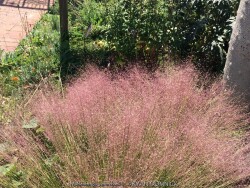

Undaunted Ruby Muhly Grass, is also known as Muhlenbergia reverchonii
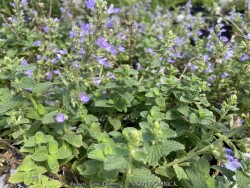

Nepeta (Catmint) Is one of the most adaptable, permanent perennials available in our climate and in your landscape! Definitely a "once it's their plant if there forever". Originally native to the Caucasus, Iran, Iraq, Turkey, there are numerous cultivars now with improved flowering and growth habit. Generally, the mint green foliage is fine textured and compact. Spring emergence in Kansas zone 6a is very early (usually in March) and will tolerate late freezes. This creates very early season interest in the garden while other plants are still dormant. Usually within a month of emerging, lavender-blue flowers cover the plant for up to six weeks. Pollinators enjoy the feast especially when catmint is used as a mass planting groundcover. Following spring flowering, many varieties develop attractive foliage and continual sporadic flowering. Some varieties have another big flower show in the fall especially if they are trimmed back and deadheaded once in late summer. Foliage is persistent and remains attractive late into the fall down to about 20° F providing late-season interest. Winter dried foliage is a somewhat attractive light gray and will eventually need to be cut or mowed to the ground before new growth emerges in the spring. Catmint is tolerant of almost any kind of soil including clay but will not tolerate poorly drained soil. Frequent watering is OK in normal garden soils but there is a risk of excessive growth and flopping. Catmint looks best in full sun but will still flower and look decent with part shade or 1/2 day full sun. This makes it adaptable to any side of the house even called northside if it gets full sun by mid-summer when the sun angle gets high. Cold hardiness or heat stress is not a problem at all in zone 6. Combine with just about any other perennial or shrub with a different flower and leaf color. It's hard to imagine a perennial or pollinator garden in Kansas without Catmint! Contrary to popular belief, cats do not destroy or eat this plant but may be attracted to it and create a nest beside it. They are really after catnip, a closely related plant. Nepeta 'Cat's Pajamas' is a long blooming perennial that's perfect in small areas of the landscape. Indigo blue flowers are produced all the way from the soil to the tips, providing an intense splash of color when it's in bloom. Rosy purple calyxes extend the color when the blooms are past peak. All Proven Winners® plants are legally propagated, healthy and vigorous, true to name, and tagged with color pictures and growing information.
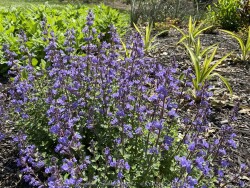

Nepeta (Catmint) Is one of the most adaptable, permanent perennials available in our climate and in your landscape! Definitely a "once it's their plant if there forever". Originally native to the Caucasus, Iran, Iraq, Turkey, there are numerous cultivars now with improved flowering and growth habit. Generally, the mint green foliage is fine textured and compact. Spring emergence in Kansas zone 6a is very early (usually in March) and will tolerate late freezes. This creates very early season interest in the garden while other plants are still dormant. Usually within a month of emerging, lavender-blue flowers cover the plant for up to six weeks. Pollinators enjoy the feast especially when catmint is used as a mass planting groundcover. Following spring flowering, many varieties develop attractive foliage and continual sporadic flowering. Some varieties have another big flower show in the fall especially if they are trimmed back and deadheaded once in late summer. Foliage is persistent and remains attractive late into the fall down to about 20° F providing late-season interest. Winter dried foliage is a somewhat attractive light gray and will eventually need to be cut or mowed to the ground before new growth emerges in the spring. Catmint is tolerant of almost any kind of soil including clay but will not tolerate poorly drained soil. Frequent watering is OK in normal garden soils but there is a risk of excessive growth and flopping. Catmint looks best in full sun but will still flower and look decent with part shade or 1/2 day full sun. This makes it adaptable to any side of the house even called northside if it gets full sun by mid-summer when the sun angle gets high. Cold hardiness or heat stress is not a problem at all in zone 6. Combine with just about any other perennial or shrub with a different flower and leaf color. It's hard to imagine a perennial or pollinator garden in Kansas without Catmint! Contrary to popular belief, cats do not destroy or eat this plant but may be attracted to it and create a nest beside it. They are really after catnip, a closely related plant. Nepeta grandiflora 'Summer Magic' is a free-blooming catmint that lives up to its namesake‚¬€it is summer magic! It blooms all season long on upright stems that never flop, even in the worst of storms. It stays fresh looking even in the heat and humidity of summer as other nepeta varieties tend to fade.
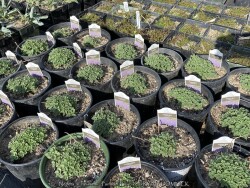

Nepeta (Catmint) Is one of the most adaptable, permanent perennials available in our climate and in your landscape! Definitely a "once it's their plant if there forever". Originally native to the Caucasus, Iran, Iraq, Turkey, there are numerous cultivars now with improved flowering and growth habit. Generally, the mint green foliage is fine textured and compact. Spring emergence in Kansas zone 6a is very early (usually in March) and will tolerate late freezes. This creates very early season interest in the garden while other plants are still dormant. Usually within a month of emerging, lavender-blue flowers cover the plant for up to six weeks. Pollinators enjoy the feast especially when catmint is used as a mass planting groundcover. Following spring flowering, many varieties develop attractive foliage and continual sporadic flowering. Some varieties have another big flower show in the fall especially if they are trimmed back and deadheaded once in late summer. Foliage is persistent and remains attractive late into the fall down to about 20° F providing late-season interest. Winter dried foliage is a somewhat attractive light gray and will eventually need to be cut or mowed to the ground before new growth emerges in the spring. Catmint is tolerant of almost any kind of soil including clay but will not tolerate poorly drained soil. Frequent watering is OK in normal garden soils but there is a risk of excessive growth and flopping. Catmint looks best in full sun but will still flower and look decent with part shade or 1/2 day full sun. This makes it adaptable to any side of the house even called northside if it gets full sun by mid-summer when the sun angle gets high. Cold hardiness or heat stress is not a problem at all in zone 6. Combine with just about any other perennial or shrub with a different flower and leaf color. It's hard to imagine a perennial or pollinator garden in Kansas without Catmint! Contrary to popular belief, cats do not destroy or eat this plant but may be attracted to it and create a nest beside it. They are really after catnip, a closely related plant.
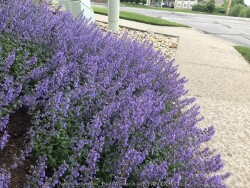

Nepeta (Catmint) Is one of the most adaptable, permanent perennials available in our climate and in your landscape! Definitely a "once it's their plant if there forever". Originally native to the Caucasus, Iran, Iraq, Turkey, there are numerous cultivars now with improved flowering and growth habit. Generally, the mint green foliage is fine textured and compact. Spring emergence in Kansas zone 6a is very early (usually in March) and will tolerate late freezes. This creates very early season interest in the garden while other plants are still dormant. Usually within a month of emerging, lavender-blue flowers cover the plant for up to six weeks. Pollinators enjoy the feast especially when catmint is used as a mass planting groundcover. Following spring flowering, many varieties develop attractive foliage and continual sporadic flowering. Some varieties have another big flower show in the fall especially if they are trimmed back and deadheaded once in late summer. Foliage is persistent and remains attractive late into the fall down to about 20° F providing late-season interest. Winter dried foliage is a somewhat attractive light gray and will eventually need to be cut or mowed to the ground before new growth emerges in the spring. Catmint is tolerant of almost any kind of soil including clay but will not tolerate poorly drained soil. Frequent watering is OK in normal garden soils but there is a risk of excessive growth and flopping. Catmint looks best in full sun but will still flower and look decent with part shade or 1/2 day full sun. This makes it adaptable to any side of the house even called northside if it gets full sun by mid-summer when the sun angle gets high. Cold hardiness or heat stress is not a problem at all in zone 6. Combine with just about any other perennial or shrub with a different flower and leaf color. It's hard to imagine a perennial or pollinator garden in Kansas without Catmint! Contrary to popular belief, cats do not destroy or eat this plant but may be attracted to it and create a nest beside it. They are really after catnip, a closely related plant. Nepeta x faassenii 'Blue Wonder' flowers that are a shade closer to blue. It will form low mounds of slightly greener leaves than most catmint. It may self-seed in optimum growing conditions in Kansas.
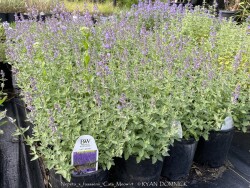

Nepeta (Catmint) Is one of the most adaptable, permanent perennials available in our climate and in your landscape! Definitely a "once it's their plant if there forever". Originally native to the Caucasus, Iran, Iraq, Turkey, there are numerous cultivars now with improved flowering and growth habit. Generally, the mint green foliage is fine textured and compact. Spring emergence in Kansas zone 6a is very early (usually in March) and will tolerate late freezes. This creates very early season interest in the garden while other plants are still dormant. Usually within a month of emerging, lavender-blue flowers cover the plant for up to six weeks. Pollinators enjoy the feast especially when catmint is used as a mass planting groundcover. Following spring flowering, many varieties develop attractive foliage and continual sporadic flowering. Some varieties have another big flower show in the fall especially if they are trimmed back and deadheaded once in late summer. Foliage is persistent and remains attractive late into the fall down to about 20° F providing late-season interest. Winter dried foliage is a somewhat attractive light gray and will eventually need to be cut or mowed to the ground before new growth emerges in the spring. Catmint is tolerant of almost any kind of soil including clay but will not tolerate poorly drained soil. Frequent watering is OK in normal garden soils but there is a risk of excessive growth and flopping. Catmint looks best in full sun but will still flower and look decent with part shade or 1/2 day full sun. This makes it adaptable to any side of the house even called northside if it gets full sun by mid-summer when the sun angle gets high. Cold hardiness or heat stress is not a problem at all in zone 6. Combine with just about any other perennial or shrub with a different flower and leaf color. It's hard to imagine a perennial or pollinator garden in Kansas without Catmint! Contrary to popular belief, cats do not destroy or eat this plant but may be attracted to it and create a nest beside it. They are really after catnip, a closely related plant. Nepeta x faassenii 'Cats Meow' in a new variety from Proven Winners® No catmint is a more beautiful, uniform grower than 'Cat's Meow' Nepeta. Its flowers are dense and colorful, and its habit is more refined. Plus, it stands strong with no flopping, getting wider and growing to a broad mound as the season progresses. All Proven Winners® plants are legally propagated, healthy and vigorous, true to name, and tagged with color pictures and growing information.
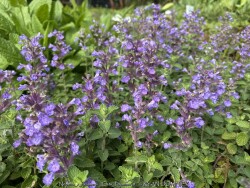

Nepeta (Catmint) Is one of the most adaptable, permanent perennials available in our climate and in your landscape! Definitely a "once it's their plant if there forever". Originally native to the Caucasus, Iran, Iraq, Turkey, there are numerous cultivars now with improved flowering and growth habit. Generally, the mint green foliage is fine textured and compact. Spring emergence in Kansas zone 6a is very early (usually in March) and will tolerate late freezes. This creates very early season interest in the garden while other plants are still dormant. Usually within a month of emerging, lavender-blue flowers cover the plant for up to six weeks. Pollinators enjoy the feast especially when catmint is used as a mass planting groundcover. Following spring flowering, many varieties develop attractive foliage and continual sporadic flowering. Some varieties have another big flower show in the fall especially if they are trimmed back and deadheaded once in late summer. Foliage is persistent and remains attractive late into the fall down to about 20° F providing late-season interest. Winter dried foliage is a somewhat attractive light gray and will eventually need to be cut or mowed to the ground before new growth emerges in the spring. Catmint is tolerant of almost any kind of soil including clay but will not tolerate poorly drained soil. Frequent watering is OK in normal garden soils but there is a risk of excessive growth and flopping. Catmint looks best in full sun but will still flower and look decent with part shade or 1/2 day full sun. This makes it adaptable to any side of the house even called northside if it gets full sun by mid-summer when the sun angle gets high. Cold hardiness or heat stress is not a problem at all in zone 6. Combine with just about any other perennial or shrub with a different flower and leaf color. It's hard to imagine a perennial or pollinator garden in Kansas without Catmint! Contrary to popular belief, cats do not destroy or eat this plant but may be attracted to it and create a nest beside it. They are really after catnip, a closely related plant. Nepeta x faassenii 'Cats Pajamas' in a new variety from Proven Winners® Unlike older varieties that only produce flowers at the top of the stems, this improved Catmint has blooms from the soil to the tips of the stems. Even when the flowers are past peak, the color of the rosy purple calyxes give your garden an additional splash of color. Compared to "Cats Meow", its flowers are the same but overall plant height is about 1/2-2/3rds. Plus, it stands strong with no flopping, getting wider and growing to a broad mound as the season progresses. All Proven Winners® plants are legally propagated, healthy and vigorous, true to name, and tagged with color pictures and growing information. PERENNIAL OF THE YEAR in 2021!
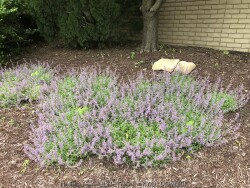

Nepeta (Catmint) Is one of the most adaptable, permanent perennials available in our climate and in your landscape! Definitely a "once it's their plant if there forever". Originally native to the Caucasus, Iran, Iraq, Turkey, there are numerous cultivars now with improved flowering and growth habit. Generally, the mint green foliage is fine textured and compact. Spring emergence in Kansas zone 6a is very early (usually in March) and will tolerate late freezes. This creates very early season interest in the garden while other plants are still dormant. Usually within a month of emerging, lavender-blue flowers cover the plant for up to six weeks. Pollinators enjoy the feast especially when catmint is used as a mass planting groundcover. Following spring flowering, many varieties develop attractive foliage and continual sporadic flowering. Some varieties have another big flower show in the fall especially if they are trimmed back and deadheaded once in late summer. Foliage is persistent and remains attractive late into the fall down to about 20° F providing late-season interest. Winter dried foliage is a somewhat attractive light gray and will eventually need to be cut or mowed to the ground before new growth emerges in the spring. Catmint is tolerant of almost any kind of soil including clay but will not tolerate poorly drained soil. Frequent watering is OK in normal garden soils but there is a risk of excessive growth and flopping. Catmint looks best in full sun but will still flower and look decent with part shade or 1/2 day full sun. This makes it adaptable to any side of the house even called northside if it gets full sun by mid-summer when the sun angle gets high. Cold hardiness or heat stress is not a problem at all in zone 6. Combine with just about any other perennial or shrub with a different flower and leaf color. It's hard to imagine a perennial or pollinator garden in Kansas without Catmint! Contrary to popular belief, cats do not destroy or eat this plant but may be attracted to it and create a nest beside it. They are really after catnip, a closely related plant. Nepeta x faassenii 'Little Trudy' is a compact, long-blooming catmint only 8-10" tall.
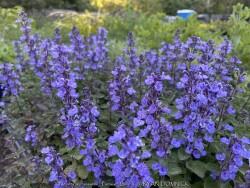

Nepeta (Catmint) Is one of the most adaptable, permanent perennials available in our climate and in your landscape! Definitely a "once it's their plant if there forever". Originally native to the Caucasus, Iran, Iraq, Turkey, there are numerous cultivars now with improved flowering and growth habit. Generally, the mint green foliage is fine textured and compact. Spring emergence in Kansas zone 6a is very early (usually in March) and will tolerate late freezes. This creates very early season interest in the garden while other plants are still dormant. Usually within a month of emerging, lavender-blue flowers cover the plant for up to six weeks. Pollinators enjoy the feast especially when catmint is used as a mass planting groundcover. Following spring flowering, many varieties develop attractive foliage and continual sporadic flowering. Some varieties have another big flower show in the fall especially if they are trimmed back and deadheaded once in late summer. Foliage is persistent and remains attractive late into the fall down to about 20° F providing late-season interest. Winter dried foliage is a somewhat attractive light gray and will eventually need to be cut or mowed to the ground before new growth emerges in the spring. Catmint is tolerant of almost any kind of soil including clay but will not tolerate poorly drained soil. Frequent watering is OK in normal garden soils but there is a risk of excessive growth and flopping. Catmint looks best in full sun but will still flower and look decent with part shade or 1/2 day full sun. This makes it adaptable to any side of the house even called northside if it gets full sun by mid-summer when the sun angle gets high. Cold hardiness or heat stress is not a problem at all in zone 6. Combine with just about any other perennial or shrub with a different flower and leaf color. It's hard to imagine a perennial or pollinator garden in Kansas without Catmint! Contrary to popular belief, cats do not destroy or eat this plant but may be attracted to it and create a nest beside it. They are really after catnip, a closely related plant. Nepeta faassenii 'Purrsian Blue' was introduced by Walter's Garden, Inc. This selection has an improved tidy habit, though it is a bit smaller and more compact in size overall than others. This is a very floriferous selection whose flower power is amplified by its having its flowers spaced closely together on the stems. Periwinkle blue flowers are coddled by dark purple calyxes just above the aromatic foliage from early summer into early fall.
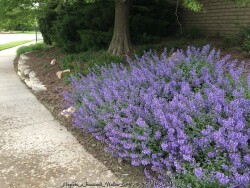

Nepeta (Catmint) Is one of the most adaptable, permanent perennials available in our climate and in your landscape! Definitely a "once it's their plant if there forever". Originally native to the Caucasus, Iran, Iraq, Turkey, there are numerous cultivars now with improved flowering and growth habit. Generally, the mint green foliage is fine textured and compact. Spring emergence in Kansas zone 6a is very early (usually in March) and will tolerate late freezes. This creates very early season interest in the garden while other plants are still dormant. Usually within a month of emerging, lavender-blue flowers cover the plant for up to six weeks. Pollinators enjoy the feast especially when catmint is used as a mass planting groundcover. Following spring flowering, many varieties develop attractive foliage and continual sporadic flowering. Some varieties have another big flower show in the fall especially if they are trimmed back and deadheaded once in late summer. Foliage is persistent and remains attractive late into the fall down to about 20° F providing late-season interest. Winter dried foliage is a somewhat attractive light gray and will eventually need to be cut or mowed to the ground before new growth emerges in the spring. Catmint is tolerant of almost any kind of soil including clay but will not tolerate poorly drained soil. Frequent watering is OK in normal garden soils but there is a risk of excessive growth and flopping. Catmint looks best in full sun but will still flower and look decent with part shade or 1/2 day full sun. This makes it adaptable to any side of the house even called northside if it gets full sun by mid-summer when the sun angle gets high. Cold hardiness or heat stress is not a problem at all in zone 6. Combine with just about any other perennial or shrub with a different flower and leaf color. It's hard to imagine a perennial or pollinator garden in Kansas without Catmint! Contrary to popular belief, cats do not destroy or eat this plant but may be attracted to it and create a nest beside it. They are really after catnip, a closely related plant. Nepeta x faassenii 'Walker Jr' is a compact, long-blooming catmint only 12-16" tall.
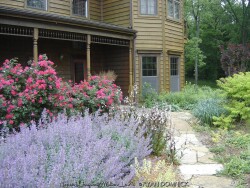

Nepeta (Catmint) Is one of the most adaptable, permanent perennials available in our climate and in your landscape! Definitely a "once it's their plant if there forever". Originally native to the Caucasus, Iran, Iraq, Turkey, there are numerous cultivars now with improved flowering and growth habit. Generally, the mint green foliage is fine textured and compact. Spring emergence in Kansas zone 6a is very early (usually in March) and will tolerate late freezes. This creates very early season interest in the garden while other plants are still dormant. Usually within a month of emerging, lavender-blue flowers cover the plant for up to six weeks. Pollinators enjoy the feast especially when catmint is used as a mass planting groundcover. Following spring flowering, many varieties develop attractive foliage and continual sporadic flowering. Some varieties have another big flower show in the fall especially if they are trimmed back and deadheaded once in late summer. Foliage is persistent and remains attractive late into the fall down to about 20° F providing late-season interest. Winter dried foliage is a somewhat attractive light gray and will eventually need to be cut or mowed to the ground before new growth emerges in the spring. Catmint is tolerant of almost any kind of soil including clay but will not tolerate poorly drained soil. Frequent watering is OK in normal garden soils but there is a risk of excessive growth and flopping. Catmint looks best in full sun but will still flower and look decent with part shade or 1/2 day full sun. This makes it adaptable to any side of the house even called northside if it gets full sun by mid-summer when the sun angle gets high. Cold hardiness or heat stress is not a problem at all in zone 6. Combine with just about any other perennial or shrub with a different flower and leaf color. It's hard to imagine a perennial or pollinator garden in Kansas without Catmint! Contrary to popular belief, cats do not destroy or eat this plant but may be attracted to it and create a nest beside it. They are really after catnip, a closely related plant. Nepeta x faassenii 'Walker's Low' is contradictorily a "tall" mounding plant grows to 2 to 3 feet tall and wide. If you want a very robust death-proof catmint, this is the one. I have also seen this plant effectively covering large sloped areas along roads with no bare spots or dead plants. Excellent when cascading off walls or container edges.


Nepeta (Catmint) Is one of the most adaptable, permanent perennials available in our climate and in your landscape! Definitely a "once it's their plant if there forever". Originally native to the Caucasus, Iran, Iraq, Turkey, there are numerous cultivars now with improved flowering and growth habit. Generally, the mint green foliage is fine textured and compact. Spring emergence in Kansas zone 6a is very early (usually in March) and will tolerate late freezes. This creates very early season interest in the garden while other plants are still dormant. Usually within a month of emerging, lavender-blue flowers cover the plant for up to six weeks. Pollinators enjoy the feast especially when catmint is used as a mass planting groundcover. Following spring flowering, many varieties develop attractive foliage and continual sporadic flowering. Some varieties have another big flower show in the fall especially if they are trimmed back and deadheaded once in late summer. Foliage is persistent and remains attractive late into the fall down to about 20° F providing late-season interest. Winter dried foliage is a somewhat attractive light gray and will eventually need to be cut or mowed to the ground before new growth emerges in the spring. Catmint is tolerant of almost any kind of soil including clay but will not tolerate poorly drained soil. Frequent watering is OK in normal garden soils but there is a risk of excessive growth and flopping. Catmint looks best in full sun but will still flower and look decent with part shade or 1/2 day full sun. This makes it adaptable to any side of the house even called northside if it gets full sun by mid-summer when the sun angle gets high. Cold hardiness or heat stress is not a problem at all in zone 6. Combine with just about any other perennial or shrub with a different flower and leaf color. It's hard to imagine a perennial or pollinator garden in Kansas without Catmint! Contrary to popular belief, cats do not destroy or eat this plant but may be attracted to it and create a nest beside it. They are really after catnip, a closely related plant.